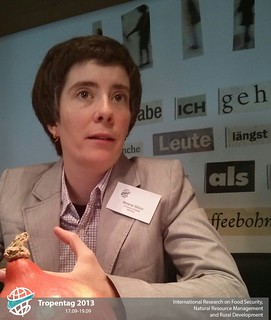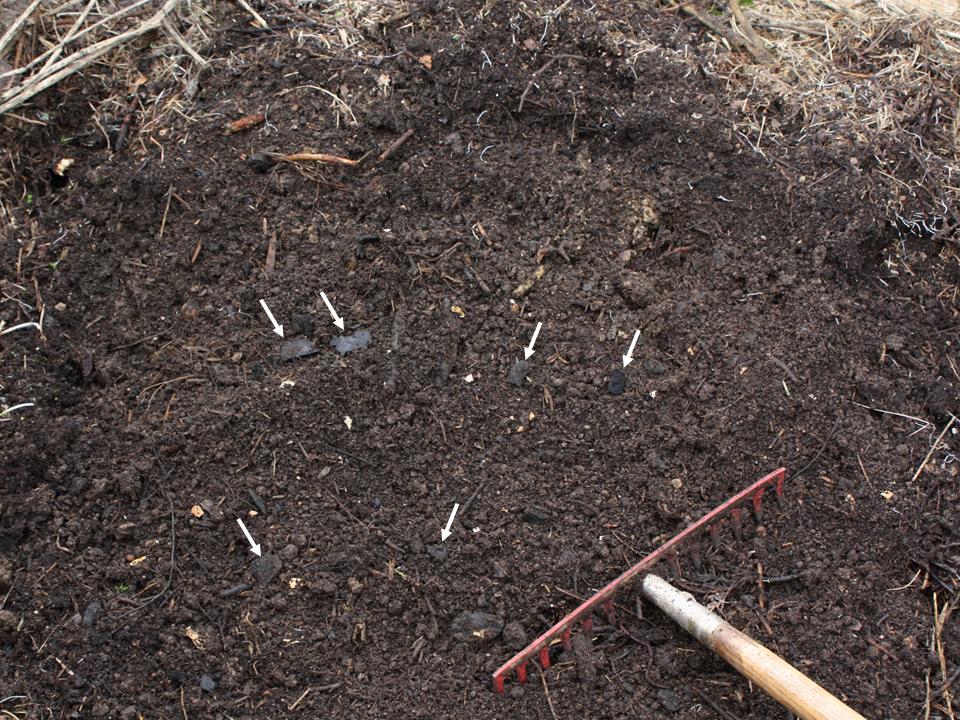Reply to comment
They Say Goats will Eat Anything -- even Charcoal
Wed, 09/18/2013 - 18:04 — Vince Canger
A team of scientists have added activated charcoal to goats' feed, utilizing the charcoal-laden faeces in attempts to decrease the amount of leaching of nitrogen and carbon in poor performing sandy soils. The results were mostly positive. But what is activated charcoal, why are they feeding it to goats, and how might it benefit soil fertility? (read more)
 A Burning Question
Melanie Willich and a team of scientists from the Univeristy of Kassel were curious to find out how the benefits of activated charcoal might be utlized in new ways in order to benefit particularly unproductive, sandy soils, which tend to easily leach precious nutrients.
Activated Charcoal (AC), also called activated carbon, is known for its high adsorption capacity due to large numbers of small, low-volume holes or pores. This allows for increased adsorbtion of different sorts of substances from gaseous to liquid phases. Therefore, AC has been used in a wide variety of instances, such as in water and air purification, the cosmetics industry, and of course agriculture.
In agriculture, AC has lead to decreasing losses of nitrogen and carbon when added to the soil by specifically increasing the water and nutrient holding capacities. But mixing AC into the soil is a difficult procedure and can itself be easily lost due to wind and water erosion as it is applied as a fine powder, explained Willich. Hence where the goats come in.
In One End and Out the Other
Although it is an interesting approach, it is not the first time that animals have been fed charcoal. Charcoal is known to have a positive effect in adsorbing harmful toxins and chemicals within the body of animals. But in order to have a positive affect on the soil, there has to be a relatively large amount of charcoal applied -- and for this study, that meant that the goats had to eat it.
The research team therefore looked at three different levels of added charcoal, keeping them within percentages tolerable to the animals, as well as a control group with no added charcoal. The resulting charcoal-laden feaces were then applied to a particular sandy-soil from Oman and anaylzed for changes in leaching of carbon and nitrogen.
Holding On to the Little that is Left
The results of the study were quite positive, although not astounding. Nevertheless, the research showed that microbial carbon and nitrogen were slightly higher in the soils applied with the AC-faeces.
Such results are promising for a few reasons. This means that effectively less AC needs to be applied as it is already incorporated into the feaces of the goats, the appliction of the AC-faeces increases the overall soil microbial biomass, and the goats also receive the positive benefits of the added charcoal to the diet with little to no negative side-effects.
A Burning Question
Melanie Willich and a team of scientists from the Univeristy of Kassel were curious to find out how the benefits of activated charcoal might be utlized in new ways in order to benefit particularly unproductive, sandy soils, which tend to easily leach precious nutrients.
Activated Charcoal (AC), also called activated carbon, is known for its high adsorption capacity due to large numbers of small, low-volume holes or pores. This allows for increased adsorbtion of different sorts of substances from gaseous to liquid phases. Therefore, AC has been used in a wide variety of instances, such as in water and air purification, the cosmetics industry, and of course agriculture.
In agriculture, AC has lead to decreasing losses of nitrogen and carbon when added to the soil by specifically increasing the water and nutrient holding capacities. But mixing AC into the soil is a difficult procedure and can itself be easily lost due to wind and water erosion as it is applied as a fine powder, explained Willich. Hence where the goats come in.
In One End and Out the Other
Although it is an interesting approach, it is not the first time that animals have been fed charcoal. Charcoal is known to have a positive effect in adsorbing harmful toxins and chemicals within the body of animals. But in order to have a positive affect on the soil, there has to be a relatively large amount of charcoal applied -- and for this study, that meant that the goats had to eat it.
The research team therefore looked at three different levels of added charcoal, keeping them within percentages tolerable to the animals, as well as a control group with no added charcoal. The resulting charcoal-laden feaces were then applied to a particular sandy-soil from Oman and anaylzed for changes in leaching of carbon and nitrogen.
Holding On to the Little that is Left
The results of the study were quite positive, although not astounding. Nevertheless, the research showed that microbial carbon and nitrogen were slightly higher in the soils applied with the AC-faeces.
Such results are promising for a few reasons. This means that effectively less AC needs to be applied as it is already incorporated into the feaces of the goats, the appliction of the AC-faeces increases the overall soil microbial biomass, and the goats also receive the positive benefits of the added charcoal to the diet with little to no negative side-effects.
 An example of Terra Preta soil. Source: Wikimedia Commons
According to Willich, the use of goat manure with incorporated AC can mimic the properties of soils such as Terra Preta, a type of soil commonly found in the Amazon basin with a very high carbon content, but at much smaller volumes.
At the moment, the study is still ongoing and further analyses of soil water, manure decomposition and microbial biomass are underway.
An example of Terra Preta soil. Source: Wikimedia Commons
According to Willich, the use of goat manure with incorporated AC can mimic the properties of soils such as Terra Preta, a type of soil commonly found in the Amazon basin with a very high carbon content, but at much smaller volumes.
At the moment, the study is still ongoing and further analyses of soil water, manure decomposition and microbial biomass are underway.
 A Burning Question
Melanie Willich and a team of scientists from the Univeristy of Kassel were curious to find out how the benefits of activated charcoal might be utlized in new ways in order to benefit particularly unproductive, sandy soils, which tend to easily leach precious nutrients.
Activated Charcoal (AC), also called activated carbon, is known for its high adsorption capacity due to large numbers of small, low-volume holes or pores. This allows for increased adsorbtion of different sorts of substances from gaseous to liquid phases. Therefore, AC has been used in a wide variety of instances, such as in water and air purification, the cosmetics industry, and of course agriculture.
In agriculture, AC has lead to decreasing losses of nitrogen and carbon when added to the soil by specifically increasing the water and nutrient holding capacities. But mixing AC into the soil is a difficult procedure and can itself be easily lost due to wind and water erosion as it is applied as a fine powder, explained Willich. Hence where the goats come in.
In One End and Out the Other
Although it is an interesting approach, it is not the first time that animals have been fed charcoal. Charcoal is known to have a positive effect in adsorbing harmful toxins and chemicals within the body of animals. But in order to have a positive affect on the soil, there has to be a relatively large amount of charcoal applied -- and for this study, that meant that the goats had to eat it.
The research team therefore looked at three different levels of added charcoal, keeping them within percentages tolerable to the animals, as well as a control group with no added charcoal. The resulting charcoal-laden feaces were then applied to a particular sandy-soil from Oman and anaylzed for changes in leaching of carbon and nitrogen.
Holding On to the Little that is Left
The results of the study were quite positive, although not astounding. Nevertheless, the research showed that microbial carbon and nitrogen were slightly higher in the soils applied with the AC-faeces.
Such results are promising for a few reasons. This means that effectively less AC needs to be applied as it is already incorporated into the feaces of the goats, the appliction of the AC-faeces increases the overall soil microbial biomass, and the goats also receive the positive benefits of the added charcoal to the diet with little to no negative side-effects.
A Burning Question
Melanie Willich and a team of scientists from the Univeristy of Kassel were curious to find out how the benefits of activated charcoal might be utlized in new ways in order to benefit particularly unproductive, sandy soils, which tend to easily leach precious nutrients.
Activated Charcoal (AC), also called activated carbon, is known for its high adsorption capacity due to large numbers of small, low-volume holes or pores. This allows for increased adsorbtion of different sorts of substances from gaseous to liquid phases. Therefore, AC has been used in a wide variety of instances, such as in water and air purification, the cosmetics industry, and of course agriculture.
In agriculture, AC has lead to decreasing losses of nitrogen and carbon when added to the soil by specifically increasing the water and nutrient holding capacities. But mixing AC into the soil is a difficult procedure and can itself be easily lost due to wind and water erosion as it is applied as a fine powder, explained Willich. Hence where the goats come in.
In One End and Out the Other
Although it is an interesting approach, it is not the first time that animals have been fed charcoal. Charcoal is known to have a positive effect in adsorbing harmful toxins and chemicals within the body of animals. But in order to have a positive affect on the soil, there has to be a relatively large amount of charcoal applied -- and for this study, that meant that the goats had to eat it.
The research team therefore looked at three different levels of added charcoal, keeping them within percentages tolerable to the animals, as well as a control group with no added charcoal. The resulting charcoal-laden feaces were then applied to a particular sandy-soil from Oman and anaylzed for changes in leaching of carbon and nitrogen.
Holding On to the Little that is Left
The results of the study were quite positive, although not astounding. Nevertheless, the research showed that microbial carbon and nitrogen were slightly higher in the soils applied with the AC-faeces.
Such results are promising for a few reasons. This means that effectively less AC needs to be applied as it is already incorporated into the feaces of the goats, the appliction of the AC-faeces increases the overall soil microbial biomass, and the goats also receive the positive benefits of the added charcoal to the diet with little to no negative side-effects.




